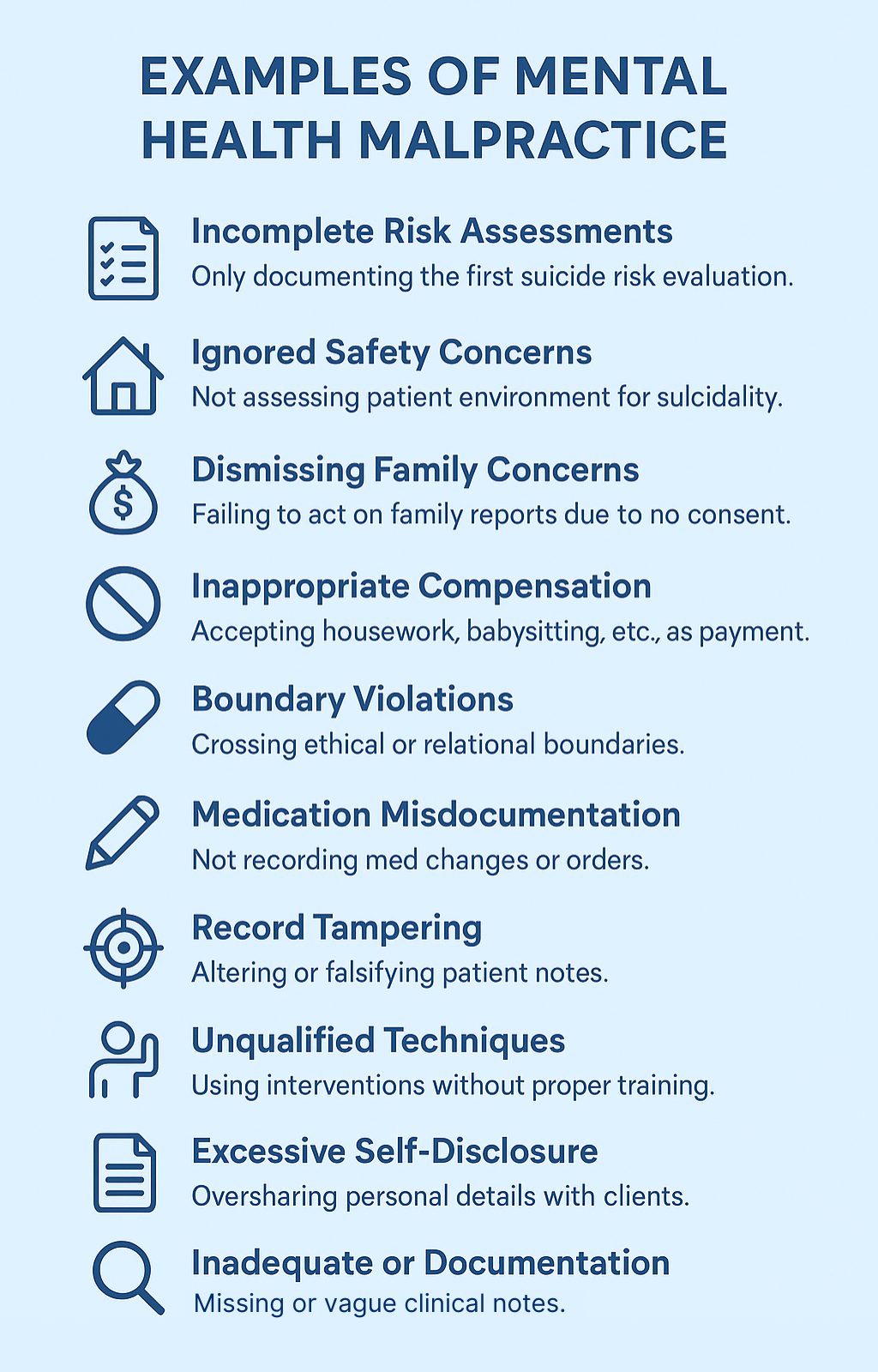Blog > Compliance > Mental Health Malpractice: Common Lawsuit Triggers and How to Protect Your Practice
Mental Health Malpractice: Common Lawsuit Triggers and How to Protect Your Practice
Clinicians face increasing legal risks, from mental health misdiagnosis lawsuits to therapist malpractice and HIPAA violations. This guide outlines the most common reasons behavioral health professionals get sued, shares real-world examples of malpractice in counseling, and offers actionable strategies to protect your license, reputation, and livelihood. Learn how to strengthen your documentation, avoid boundary violations, manage informed consent, and reduce exposure to false claims using tools like ICANotes.

Last Updated: August 5, 2025


What You'll Learn
-
The most common reasons clinicians face mental health malpractice lawsuits, including real-world examples of therapist and counselor negligence
-
How to improve documentation practices to reduce legal risk and support insurance audits or court proceedings
-
What informed consent should include—and where to find state-specific requirements for tailoring your forms
-
How EHR systems like ICANotes help mitigate risk through compliant note templates, consent tracking, and audit-readiness tools
Contents
Behavioral health clinicians rarely enter the profession thinking about courtroom defenses. Yet legal action is a real risk that can threaten your license, reputation, and financial stability. While mental health professionals face fewer lawsuits than providers in high-risk medical specialties, lawsuits for therapist malpractice and mental health misdiagnosis are increasing.
Whether you’re in solo practice or a group setting, understanding common legal pitfalls can help you stay compliant and confident. This guide explores top causes of litigation, offers examples of malpractice in counseling, and provides practical strategies to protect your practice.
Why Mental Health Professionals Get Sued
While most clinicians will never face a malpractice lawsuit, the consequences for those who do can be devastating. The emotional and financial costs of defending against mental health litigation often far outweigh the odds of actually losing the case.
Common claims include:
- Therapy malpractice due to boundary violations (e.g., romantic or dual relationships)
- Counselor malpractice involving poor documentation
- Misdiagnosis or failure to assess risk (especially in suicide-related cases)
- Breach of patient data or confidentiality
- Lack of informed consent
- Failure to report abuse or follow mandatory reporting laws
According to a 2023 analysis by the American Professional Agency, up to 44% of malpractice claims in therapy involve boundary violations, while documentation failures are present in about 20% of cases.
To successfully make a mental health malpractice claim, a patient needs to be able to establish all of the following factors:
- A patient-clinician relationship existed
- The clinician breached their duty of reasonable care
- The patient was injured mentally or physically
- The psychiatrist’s negligence caused the injury
The key to remember is that you must have acted negligently for there to be a malpractice lawsuit.
Free Download: Malpractice Risk Assessment Guide for Mental Health Clinicians
Even well-meaning clinicians can get caught off guard by malpractice lawsuits, board complaints, or HIPAA violations. Download this free guide that will help you take practical steps to safeguard your practice.
✅ Identify the top malpractice red flags in documentation
✅ Evaluate your informed consent and risk assessment processes
✅ Learn how to strengthen boundaries and defend your decisions in court or audits
✅ Get actionable tips to reduce legal risk

Real-World Examples of Malpractice in Counseling
- Psychologist malpractice case (Italy): A therapist was found liable for implanting false memories of abuse in a young client through suggestive questioning.
- Therapist malpractice (U.S.): A Florida clinician was criminally charged after engaging in a sexual relationship with a 15-year-old client during sessions held in hotel rooms.
- Counseling malpractice by omission: Failing to document a client's suicide risk or to use standardized risk assessment tools can result in a lawsuit, even if the therapist's actions were otherwise sound.
Each of these scenarios underscores how crucial documentation, ethical boundaries, and informed consent are in avoiding therapy malpractice.
Misdiagnosis and Mental Health Litigation
Misdiagnosis lawsuits in mental health are growing. A 2023 study revealed that nearly 800,000 Americans suffer permanent disability or death annually due to medical misdiagnoses—a concern that extends to behavioral health. On an annual basis, roughly 2% to 3% of psychiatrists are facing a malpractice suit (compared with 7% of physicians as a whole and 19% of neurosurgeons).
To avoid mental health misdiagnosis lawsuits:
- Use validated screening tools (e.g., PHQ-9, Columbia Suicide Severity Rating Scale)
- Document clinical rationale for diagnoses
- Note verbatim client statements
- Seek supervision or peer consultation for complex cases
Platforms like TikTok are increasingly being used by clients to publicly discuss grievances with therapists. These posts often lack context and can prompt others—including fellow therapists—to weigh in without full knowledge. This trend has led to:
- Increased scrutiny of therapists online
- Public encouragement to pursue litigation
- Reputational harm from viral misinformation

How to Protect Yourself on Social Media
Clinicians don't have to avoid social media entirely, but they do need to engage carefully and ethically. These guidelines can help you minimize the risk of counseling malpractice or licensing board complaints stemming from online activity:
-
Never respond to client reviews — even to defend yourself.
Under HIPAA, acknowledging that someone is your client is a privacy violation, even if they’ve publicly posted about you. In one case, a psychologist was fined $50,000 for disclosing PHI in a Yelp response to a negative review. -
Don’t use client stories (even anonymously) for educational content.
If you share clinical anecdotes on LinkedIn, a blog, or a podcast, ensure there’s zero chance the client could be identified—even by themselves. Combining demographic details (age, location, diagnosis) could unintentionally expose them. -
Use separate personal and professional accounts.
Maintain clear boundaries. Avoid adding clients as friends or followers and set your personal profiles to private. On professional accounts, don’t post anything you wouldn’t include in a clinical chart or defend in a court deposition. -
Avoid offering therapeutic advice or interpreting symptoms online.
Engaging in clinical dialogue via comment threads or DMs can blur boundaries and even be construed as entering into a therapeutic relationship without consent or documentation. -
Know your state’s rules on teletherapy and digital conduct.
Some licensing boards explicitly restrict digital interactions, including texting or online advice. Violating these rules, even with good intentions, can lead to complaints or loss of licensure. -
Document social media disclosures in the consent process.
If you maintain a professional presence online (e.g., YouTube channel, Facebook group), inform clients in your consent form about boundaries and whether you may be publicly visible.
Confidentiality Breaches and HIPAA Violations
Breaching confidentiality is one of the fastest ways to erode client trust and attract legal consequences. Even unintentional HIPAA violations can lead to hefty fines and reputational damage.
Examples of real HIPAA violations in mental health care:
-
Private practice in Colorado (2023): A mental health clinician was fined $50,000 for failing to provide a patient with timely access to their medical records.
-
Georgia psychiatric facility (2022): The provider paid a $65,000 penalty after a former employee accessed patient records without proper termination of their login credentials.
-
Social media disclosure (2020): A therapist responded to a negative client review online by confirming the therapeutic relationship—an action that resulted in a $10,000 fine for violating confidentiality.
How to reduce your risk:
-
Use secure, HIPAA-compliant software for documentation and communication
-
Revoke former employees' access to EHR systems immediately
-
Never acknowledge a therapeutic relationship publicly unless explicitly authorized
-
Train staff regularly on privacy rules and data protection
Maintaining airtight confidentiality protocols protects clients and shields your practice from regulatory scrutiny.
Documentation: Your Best Legal Defense
Proper documentation is essential. It not only supports continuity of care but also protects you in case of a mental health lawsuit, insurance audit, or licensing board complaint. Courts and regulatory agencies often interpret poor records as evidence of poor care—even if your clinical decisions were sound.
Behavioral health documentation best practices include:
- Document within 24 hours of the session:
Timely notes are critical. In one malpractice case, a counselor’s delay in documenting a suicide risk assessment raised questions about whether the assessment ever took place. Late entries weaken your legal credibility. - Include verbatim statements when relevant:
Direct client quotes (e.g., “I feel like I have nothing to live for”) can demonstrate risk awareness and show that you took client concerns seriously. These statements also help defend against claims of negligence or failure to respond to client distress. - Link progress notes to the treatment plan:
Notes should clearly reflect progress toward identified goals. For example, if a client’s treatment plan includes “develop coping skills for panic attacks,” your note might read, “Practiced grounding techniques; client reported reduced intensity of symptoms.” This linkage shows medical necessity and supports reimbursement. - Use objective, professional language:
Avoid judgmental or emotionally charged descriptions (e.g., “client was manipulative”). Instead, describe behaviors and your clinical observations: “Client repeatedly changed answers during safety planning; ambivalence about treatment noted.” - Avoid copy-pasting prior notes:
Repetitive documentation (sometimes called “note cloning”) can signal to auditors or attorneys that services weren’t individualized. In some therapy malpractice lawsuits, identical notes across sessions undermined the therapist’s defense that care was adapted to client needs.
Even though clients can access their records under information-blocking rules, psychotherapy notes—kept separate from the medical record—may remain private. However, even these can be subpoenaed during litigation. That’s why all documentation should meet the highest standards of accuracy, clarity, and clinical relevance.
How EHRs Help Prevent Legal Complications
Electronic Health Records (EHRs) are not just tools for efficiency—they are critical safeguards for legal protection. A well-designed EHR system ensures timely documentation, enforces clinical workflows, and standardizes compliance practices.
Benefits of using an EHR to reduce legal risk:
- Time-stamped entries that verify documentation occurred close to the session date
- Templates and prompts to ensure thorough, consistent notes
- Secure access logs that track who accessed a client record
- Integrated informed consent forms and treatment plans
- Easy access to audit trails and risk assessment tools
Why ICANotes Is a Risk-Reduction Powerhouse
ICANotes is purpose-built for behavioral health and is designed with compliance and legal protection in mind. Here's how ICANotes helps mitigate risk:
- Pre-built clinical content: Reduces variability and helps ensure documentation meets medical necessity standards
- Support for verbatim statements: Easily document client quotes for added legal protection
- Built-in treatment planning and progress note integration: Ensures every session aligns with the client’s care goals
- HIPAA-compliant cloud infrastructure: Minimizes the risk of data breaches
- Structured risk assessments: Including tools like the Columbia Suicide Severity Rating Scale to help document suicide risk consistently
- Audit-friendly note structure: Clear, concise language that’s hard to misinterpret in legal settings
By streamlining clinical documentation while enforcing best practices, ICANotes helps you document defensibly, protect your license, and reduce the stress of compliance.
Informed Consent and Risky Treatments
Only 26% of consent forms include detailed information about treatment purpose, risks, and alternatives. Informed consent protects both clinician and client.
To stay protected:
- Tailor consent forms to your state’s requirements
- Use additional consents for specialized therapies (e.g., EMDR)
- Clearly explain limits of confidentiality, including duty to warn
- Obtain electronic or physical signatures

Tip: Want to make sure your informed consent forms meet state requirements?
Start by checking your state licensing board’s website for your profession (e.g., counseling, psychology, social work). You can also find state-specific guidance through professional associations, malpractice insurers, or legal portals like Justia. For complex or high-risk services, consult a behavioral health attorney to ensure full compliance.
Fraud and False Claims: A Growing Legal Risk
Mental health providers who submit claims to insurance, especially Medicare or Medicaid, can face steep penalties for billing errors that fall under the False Claims Act. These don’t require intent to defraud. Simple documentation lapses, upcoding, or billing for services not rendered can all trigger audits, clawbacks, or worse.
Common pitfalls include:
- Billing for sessions not properly documented
- Upcoding services to higher-paying CPT codes without justification
- Providing services outside your scope of practice or licensure
- Copy-pasting notes across sessions (suggests services were not individualized)
- Failing to obtain or update treatment plans for reimbursable therapy
The Office of Inspector General (OIG) and state Medicaid agencies have increasingly scrutinized behavioral health services. Even honest mistakes can be costly, with penalties reaching tens of thousands of dollars per claim.
Protect yourself by:
- Using a behavioral health EHR like ICANotes to generate complete, audit-ready notes
- Regularly reviewing payer guidelines for documentation and coding
- Performing internal chart audits or hiring a compliance consultant
- Avoiding shortcuts like auto-cloning progress notes across sessions
If you're audited, your documentation will be the first, and possibly only, line of defense.
Additional Legal Risk-Reduction Strategies
While documentation and informed consent are foundational, reducing your legal exposure also requires proactive systems, ongoing training, and ethical vigilance. Below are additional strategies clinicians can implement to strengthen their legal safeguards and reduce the likelihood of a malpractice claim or regulatory penalty.
- Conduct safety planning for clients with suicide risk; safety contracts are insufficient.
- Use evidence-based risk assessments at every session (e.g., C-SSRS)
- Carry robust malpractice insurance that covers your scope of services
- Maintain HIPAA compliance to avoid costly data breaches
- Know your scope of practice and state-specific reporting laws
Frequently Asked Questions
Final Thoughts on Mental Health Malpractice
Therapist malpractice claims are rare but rising. With increased visibility, evolving laws, and a culture of public scrutiny, clinicians must be more vigilant than ever.
Proactive documentation, clear boundaries, thorough informed consent, and ongoing risk assessment are your strongest legal safeguards.
And by using a behavioral health EHR like ICANotes, you give yourself an extra layer of protection through structured, compliant, and defensible clinical documentation.
Because when your notes tell a clear story—with evidence, compassion, and professionalism—you stand on solid ground if scrutiny ever comes.
Schedule a Live Demo
Experience the most intuitive, clinically robust EHR designed for behavioral health professionals—built to streamline documentation, improve compliance, and enhance patient care.
- Simplify clinical charting
- Stay organized with appointment scheduling
- Reduce no-shows with automated reminders
- Improve client engagement with a secure patient portal
- Provide flexible care with HIPAA-compliant telehealth
Simplify clinical charting
Stay organized with appointment scheduling
Reduce no-shows with automated reminders
Improve client engagement with a secure patient portal
Provide flexible care with HIPAA-compliant telehealth
Related Posts
Dr. October Boyles is a behavioral health expert and clinical leader with extensive expertise in nursing, compliance, and healthcare operations. With a Doctor of Nursing Practice (DNP) from Aspen University and advanced degrees in nursing, she specializes in evidence-based practices, EHR optimization, and improving outcomes in behavioral health settings. Dr. Boyles is passionate about empowering clinicians with the tools and strategies needed to deliver high-quality, patient-centered care.










How Social Media Is Fueling Mental Health Lawsuits